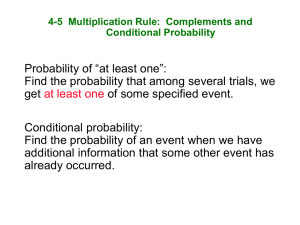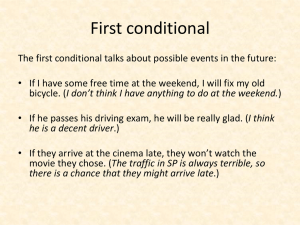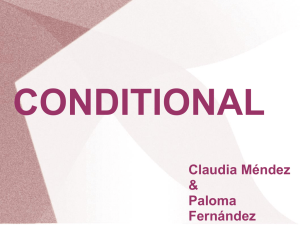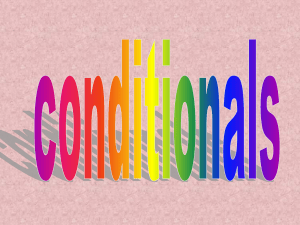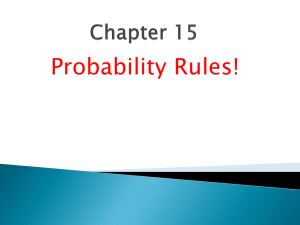PPT
advertisement
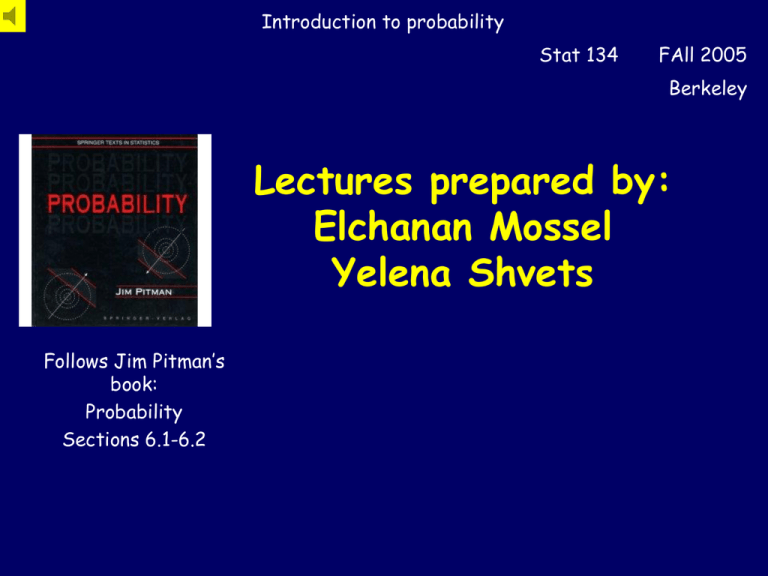
Introduction to probability
Stat 134
FAll 2005
Berkeley
Lectures prepared by:
Elchanan Mossel
Yelena Shvets
Follows Jim Pitman’s
book:
Probability
Sections 6.1-6.2
# of Heads in a Random # of Tosses
•Suppose a fair die is rolled and let N be the number
on top.
N=5
•Next a fair coin is tossed N times and H, the
number of heads is recorded:
H=3
Question:
Find the distribution of H, the number of heads?
# of Heads in a Random Number of Tosses
Solution:
•The conditional probability for the H=h, given N=n is
•By the rule of the average conditional probability
and using P(N=n) = 1/6
h
0
1
2
3
4
5
P(H=h) 63/384 120/384 99/384 64/384 29/384 8/384
6
1/384
Conditional Distribution of Y given X =x
Def: For each value x of X, the set of probabilities
P(Y=y|X=x)
where y varies over all possible values of Y, form a
probability distribution, depending on x, called
the conditional distribution of Y given X=x.
Remarks:
•In the example P(H = h | N =n) ~ binomial(n,½).
•The unconditional distribution of Y is the average of the
conditional distributions, weighted by P(X=x).
Conditional Distribution of X given Y=y
Remark: Once we have the conditional distribution of Y given
X=x, using Bayes’ rule we may obtain the conditional
distribution of X given Y=y.
•Example: We have computed distribution of H given N = n:
•Using the product rule we can get the joint distr. of H and N:
•Finally:
Number of 1’s before the first 6.
Example: Roll a die until 6 appears.
Let Y = # 1’s and X = # of Rolls.
Question: What is the Distribution of Y?
Solution:
1 – Find distribution of X:
so X»Geom(1/6).
2- Find conditional distribution of Y given X=x.
so P(Y|X=x)»Bin(x-1,1/5).
Number of 1’s before the first 6.
3- Use the rule of average conditional probabilities to compute the
unconditional distribution of Y.
So Y = G-1, where
G = Geom(1/2)
Conditional Expectation Given an Event
Definition: The conditional expectation of Y given
an event A, denoted by E(Y|A), is the expectation
of Y under the conditional distribution given A:
E(Y|A) = all y y P(Y=y|A).
Example: Roll a die twice; Find E(Sum| No 6’s).
X+Y
(X,Y)
1
2
3
4
5
6
1
1,1
2
1,2
3 1,3
4 1,4
5 1,5
6 1,6
7
2
2,1
3 2,2
4 2,3
5 2,4
6 2,5
7 2,6
8
3
3,1
4 3,2
5 3,3
6 3,4
7 3,5
8 3,6
9
4
4,1
5 4,2
6 4,3
7 4,4
8 4,5
9 4,6
10
5
5,1
6 5,2
7 5,3
8 5,4
9 5,5
10 5,6
11
6
6,1
7 6,2
8 6,3
9 6,4
10 6,5
11 6,6
12
E(X+Y|No 6’s) =
(2*1+ 3*2+ 4*3 + 5*4 +6*5 +
7*4 + 8*3 + 9*2 + 10*1)/25
=6
Claim:
Linearity of Conditional
Expectation
For any set A:
E(X + Y | A) = E(X|A) + E(Y|A).
Proof: E(X + Y|A) =
all (x,y) (x+y) P(X=x & Y=y|A)
= all x x all y P(X=x & Y = y| A)
all y y all x P(Y=y & X = x | A)
= all x x P(X=x | A)
all y y P(Y=y | A)
=
E(X|A) + E(Y|A).
Using Linearity for 2 Rolls of Dice
Example: Roll a die twice; Find E(Sum| No 6’s).
E(X+Y|X6 & Y6) = E(X|X6 & Y6)+E(Y|X6 & Y6)
=2 E(X|X6)
= 2(1 + 2 + 3 + 4 + 5)/5
=6
Conditional Expectation
Claim: For any Y with E(Y) < 1 and any discrete X,
E(Y) = all x E(Y|X=x) P(X=x).
This is called the “rule of average conditional
expectation”.
Definition of conditional expectation:
The conditional expectation of Y given X ,
denoted by E(Y|X), is a random variable that
depends on X. It’s value, when X = x, is E(Y|X=x).
So if Z = E[Y | X] then
P[Z = z] = { P(x) : E(Y | X = x) = z}
Compact form of rule of average conditional E’s :
E[Y] = E[E(Y|X)]
Conditional Expectations: Examples
Example:
Let N = number on a die,H = # of heads in N tosses.
Question: Find E(H|N).
Solution:
We have seen that P(H|N=n)»Bin(n,½). So E(H|N=n) = n/2. and
therefore E(H|N) = N/2.
Question: Find E(H).
Solution: This we can do by conditioning on N:
E(H) = E(E(H|N)) = E(N/2) = 3.5/2 = 1.75.
Conditional Expectation - Examples
Roll a die until 6 comes up.
N= # of rolls; Y = # of 1’s.
Question: Compute E[Y].
Solution: We will condition on N: E[Y] = E[ E[Y|N]].
Then: E[Y|N=n] = (N-1)/5.
N » Geom(1/6) and E[N] = 6. Thus
E[Y] = E[E[Y|N]] = E[(N-1)/5] = 1.
Note: We’ve seen before then Y = G – 1 where
G ~ Geom(1/2). This also gives: E[Y] = 2-1 = 1.
Conditional Expectation
Roll a die until 6 comes up.
S=sum of the rolls; N = # of rolls.
Question: Compute E[S],
Solution: We will condition on N: E[S] = E[ E[S|N]].
Need: E[S|N=n] ;
Let Xi denote the # on the ith roll die.
E [S|N=n] = E(X1 + … + Xn) = 3.5 n; so E[S|N] =3.5N.
N» Geom(1/6) and E[N] = 6. Thus
E[S] = 3.5E[N] = 3.5 * 6 = 21.
Success counts in overlapping series of trials
Example:
Let Sn number of successes in n independent trials with
probability of success p.
Question: Calculate E(Sm|Sn=k) for m· n
Solution:
Sm = X1 + … + Xm, where Xj is indicator of success on jth trial.
E(Sm | Sn = k) =
n
E(X
j
| Sn = k)
j=1
E(Xj | Sn = k) = P(j
=
th
P(j
trial is a success
th
| Sn = k)
trial is a success, k - 1 of other n - 1 trials are successes)
P(Sn = k)
n - 1 k -1
n -k
p
p (1 - p)
k
k - 1
=
=
;
n
n
k
n -k
p
(1
p)
k
E(Sn | Sm = k) =
mk
n
.
Conditional Expectation
Comment: Conditioned variables can be treated as
constants when taking expectations:
E[g(X,Y)|X=x] = E[g(x,Y)|X=x]
Example:
E[XY|X=x] = E[xY|X=x] = xE[Y|X=x];
so as random variables:
E[XY|X] = XE[Y|X].
Example: E[aX + bY|X] = aX + bE[Y|X];
Question: Suppose X and Y are independent, find E[X+Y|X].
Solution: E(X+Y|X) = X + E(Y|X) = X + E(Y), by independence.

